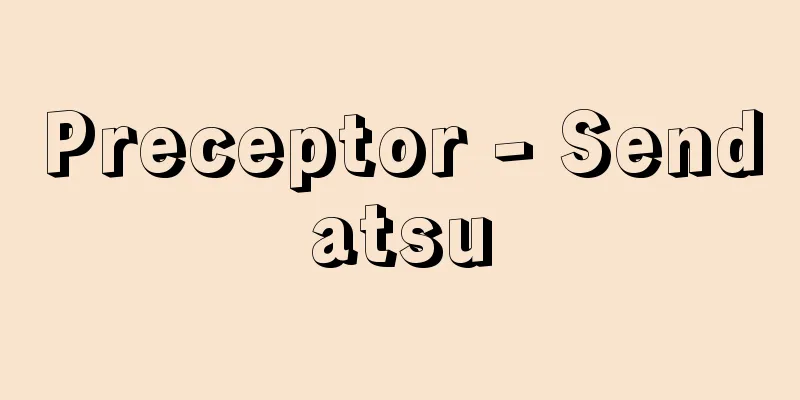Preceptor - Sendatsu

|
〘noun〙① To be the first to reach a certain path in learning, art, training, etc. and to lead others. Also, the person. A senior. Sendachi. ※Shichu Gunyo (1071 or so) 1 ``The first consultation with the chamberlain, <abbreviated> The chamberlain opens the document and attaches it briefly, <abbreviated> The chamberlain follows the manner of the chamberlain , and eats it.'' ※Yonezawa Honshasekishu (1283) 10th end ``The matters of the leaders (sendatsu) of various sects in the Middle Ages are recorded in the chronicles.'' [Book of the Later Han - Zhu Hui Biography] ② To lead other practitioners, especially in Shugendo. Also, the person. An accomplished mountain ascetic who leads the accompanying Shugendo practitioners when entering mountain peaks, etc. Sendachi. ※Gonijo Michimichi-ki, November 11, 1090 (Kanji 4), “The case, etc .: The misdeeds of the Kumano guide.” ※Ukiyo-zoshi, Koshoku Ichidai Otoko (1682), 2 “A man named Dairakuin, a mountain priest in the upper region, was a guide (sentasu) and entered the mountain.” ③ In general, to guide. Also, that person. Guide. Leader. Sendachi. ※Azuma Kagami, September 20, 1180 (Jisho 4), “As early as possible, Hojo -dono became a guide , and he came to the Kise Riverside.” ※Tsurezuregusa (Essays in Tsurezuregusa) (around 1331), 52 “It is desirable to have a guide even for small matters.” [Glossary] (1) As a Chinese word, it means ①, but from the late Heian period onwards, as Shugendo became more popular, it came to be widely used to mean ②. (2) Regarding the reading, the old dictionary "Iroha Jiruisho" has it as "sen-tatsu", but in the Middle Ages, some dictionaries had it as "sen-dachi" reflecting the variation in the writing of the syllable ending of the character "達" (Gegakushu, Bunmeihon Setsuyoshu, Ikyoshu, Manjuyahon Setsuyoshu, etc.), some had it as "sen-datsu" (Meiohon Setsuyoshu, Tenshohon Setsuyoshu, Kurohon Setsuyoshu, Eirinhon Setsuyoshu, etc.), and some had both (Nippo Jisho). However, after the Edo period, it was gradually unified as "sen-datsu". Sen-dachi [Guide]Sen-datte [sendai]Source: The Selected Edition of the Japanese Language Dictionary About the Selected Edition of the Japanese Language Dictionary Information |
|
〘名〙① 学問・技芸・修行などで、先にその道に達し、他を導くこと。また、その人。先輩。せんだち。※侍中群要(1071か)一「蔵人初参事〈略〉先達蔵人開レ簡テ付レ簡了〈略〉随二先達気色一、食レ之了」※米沢本沙石集(1283)一〇末「中古の諸宗の先達(センダツ)の事は伝にのせたり」 〔後漢書‐朱暉伝〕② 特に修験道で、他の修行者を導くこと。また、その人。峰入りなどの時に、同行の修験者の先導となる熟達した山伏。せんだち。※後二条師通記‐寛治四年(1090)一一月一一日「件文等号二熊野先達悪事一」※浮世草子・好色一代男(1682)二「㝡上の山伏大楽院といふ人先達(センタツ)して峯入とて」③ 一般に、案内すること。また、その人。案内者。指導者。せんだち。※吾妻鏡‐治承四年(1180)九月二〇日「早以二北条殿一為二先達一、可レ被レ来二向黄瀬河辺一之旨」※徒然草(1331頃)五二「すこしのことにも、先達はあらまほしき事なり」[語誌](1)漢語としては、①の意であるが、平安時代後期以降、修験道が盛んになるにつれ、②の意で広く使用されるようになった。 (2)読みについて、古辞書の類では「色葉字類抄」には「センタツ」とあるが、中世には、「達」字の入声韻尾の表記の揺れを反映して「センダチ」とあるもの(「下学集」「文明本節用集」「伊京集」「饅頭屋本節用集」など)や、「センダツ」とあるもの(「明応本節用集」「天正本節用集」「黒本本節用集」「易林本節用集」など)、両者を挙げるもの(「日葡辞書」)など様々である。しかし江戸時代以後は、次第に「センダツ」に統一されるようになった。 せん‐だち【先達】せん‐だって【先達】出典 精選版 日本国語大辞典精選版 日本国語大辞典について 情報 |
Recommend
Oyu ruins - Oyu ruins
… Although unrelated to agricultural rituals, sto...
Color printing
→Multi-color printing Source : Heibonsha Encyclope...
Extreme Magnitude - Extreme Magnitude
The faintest magnitude of a star that can be detec...
Sphoṭa (English spelling)
An important concept in Indian linguistic theory. ...
Di Ren-jie (English spelling)
[Life] Jogan 4 (630) [Died] Kushi 1 (700). Septemb...
Murderous clothing - Kyofuku
〘 noun 〙 Clothing worn during mourning. Also, the ...
Wing chord
… [Names of each part of the wing] An airfoil usu...
Chu Ci - Soji
The name of a book that collected the 'Shufu&...
Aremonite - Aremonko
...More than 30 kinds of elemental minerals are k...
Substrate - Kiban (English spelling)
A plate-like object on or within which active elem...
Faith - shinkou (English spelling) faith English
It is a mental attitude in which one has a whole-...
Miyama [town] - Miyama
An old town in Kitamuro District facing the Kumano...
Young women - Onago Wakaishu
...an age group of young women that was once form...
Leveling - Suijunsokuryo (English spelling)
A survey to determine the height of each point on...
Hunger - Kigakkan
1. Feeling hungry. Feeling like you need water or ...









